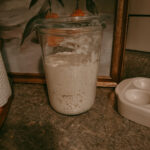Description
Make your own sourdough starter from scratch and finally step into your sourdough journey filled with deliciousness!
Ingredients
Bread Flour
Spring Water or Filtered Water
Instructions
- On day one mix together 50g flour and 50g water. Mix vigorously in a clean jar making sure to scrape down sides. Cover loosely with a lid or tea towel. Leave on your counter for 24 hours.
- On day two discard half of your starter and again feed with 50g flour and 50g water. Cover loosely with lid and wait 24 hours.
- On days three-five repeat everything in day two instructions.
- On days six-seven repeat the same method except begin feeding starter every 12 hours.
- On day seven-ten your starter might be ready to bake with. You will know it's ready if it has bubbles and it doubles in size. You can also try the float test*.
Notes
Maintaining Your Sourdough Starter
Once your sourdough starter is lively and thriving, it requires ongoing care to ensure its longevity for years to come.
Refrigerator Storage for Occasional Use:
- Storing your starter in the refrigerator slows down its fermentation process, so feeding once every week will be enough.
- If I want to use my sourdough I bring it out of the refrigerator a day or two before I need it and I feed it once each day before using it. I then feed it again after using it in my recipe and pop it back in the refrigerator with a lid.
Counter Storage for Daily Use:
- The bacteria in the starter are active at room temperature, meaning they need more frequent feeding if kept on the counter.
- Leaving your starter on the counter requires daily feeding with flour and water. This routine is ideal if you're baking daily and using up the starter regularly.
- However, for most people who don't bake daily, I recommend storing the starter in the refrigerator between uses to maintain its freshness and reduce the frequency of feedings. This also saves you from using up your ingredients constantly.
*Float Test: The float test consists of filling a cup of water and dropping a dollop of sourdough starter. If the starter floats then it is ready to bake with, if it sinks then it needs more time to activate.
- Category: Sourdough
